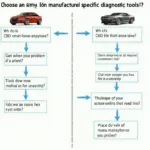The ISO 15765 standard defines the implementation of diagnostics over Controller Area Network (CAN) for On-Board Diagnostics (OBD2). This protocol is crucial for how modern vehicles communicate diagnostic information. Understanding the ISO 15765 CAN OBD2 protocol is essential for anyone working with vehicle diagnostics, from professional mechanics to DIY enthusiasts.
The ISO 15765 standard outlines how diagnostic trouble codes (DTCs), sensor data, and other diagnostic information are transmitted over the CAN bus, a high-speed network connecting various electronic control units (ECUs) within a vehicle. This protocol allows OBD2 scanners to communicate with these ECUs, retrieve diagnostic information, and even perform certain functions like resetting fault codes.
What is ISO 15765 and How Does it Relate to OBD2?
ISO 15765 essentially bridges the gap between the general OBD2 requirements and the specifics of using the CAN bus for communication. It dictates the formatting, timing, and structure of messages sent and received during diagnostic sessions. This standardization ensures interoperability between different OBD2 scanners and vehicles, regardless of the manufacturer. Choosing the right scanner is important and we’ve reviewed the best obd2 bluetooth adapter options available.
Key Components of ISO 15765
- Network Layer: Defines the physical and data link layers using the CAN protocol.
- Transport Layer: Handles the segmentation and reassembly of larger diagnostic messages into smaller CAN frames.
- Application Layer: Specifies the diagnostic services and data interpretation based on the OBD2 standard.
These layers work together seamlessly to ensure reliable and consistent diagnostic communication over the CAN bus.
Why is ISO 15765 Important?
Without the ISO 15765 standard, there would be no consistent way to access diagnostic information from vehicles using the CAN bus. This protocol allows for efficient and standardized communication, enabling accurate diagnostics and troubleshooting. It’s what makes it possible for a vw golf obd2 scanner to work seamlessly.
Benefits of using ISO 15765:
- Standardized Communication: Enables compatibility across different vehicle makes and models.
- Efficient Data Transfer: The CAN bus and ISO 15765 allow for fast and reliable data transfer.
- Advanced Diagnostics: Supports more sophisticated diagnostic capabilities compared to older protocols.
“Standardization is key in the automotive industry. ISO 15765 allows us to develop diagnostic tools that can work with a wide range of vehicles,” says Alex Thompson, Senior Automotive Engineer.
Common Use Cases of ISO 15765
ISO 15765 is used in numerous scenarios:
- Reading and Clearing DTCs: Accessing and clearing diagnostic trouble codes to identify and resolve vehicle issues.
- Live Data Streaming: Monitoring real-time sensor data to analyze vehicle performance and identify potential problems.
- ECU Coding and Programming: Performing advanced functions like ECU coding and programming using specialized diagnostic tools.
If you’re looking for a specific adapter, you might be interested in the bluetooth obd2 adapter for ktm duke 200 390 rc200 390.
Troubleshooting ISO 15765 Communication Issues
Occasionally, problems can arise with ISO 15765 communication. Here are some common troubleshooting steps:
- Check Connections: Ensure the OBD2 scanner is properly connected to the vehicle’s OBD2 port.
- Verify CAN Bus Integrity: Inspect the CAN bus wiring for any damage or loose connections.
- Check for Compatibility: Confirm that the OBD2 scanner is compatible with the vehicle’s make, model, and year. Some older vehicles may utilize different protocols such as the one described on our rx8 obd2 protocol page.
“Always double-check your connections and compatibility before diving into complex diagnostics,” advises Maria Sanchez, Certified Automotive Technician.
Looking for a versatile OBD2 reader? Check out our bluetooth obd2 reader usb options.
Conclusion
The ISO 15765 CAN OBD2 protocol is a fundamental element of modern vehicle diagnostics. Understanding its role in facilitating communication between OBD2 scanners and vehicle ECUs is essential for effective troubleshooting and maintenance. This protocol allows for standardized, efficient, and advanced diagnostics, making it a crucial component of the automotive industry.
FAQ
- What is ISO 15765? It’s the standard that defines how OBD2 diagnostics are implemented over a CAN bus.
- Why is ISO 15765 important? It ensures compatibility and efficient communication between OBD2 scanners and vehicles.
- What are the main components of ISO 15765? Network layer, transport layer, and application layer.
- How can I troubleshoot ISO 15765 communication issues? Check connections, verify CAN bus integrity, and confirm compatibility.
- What are some common uses of ISO 15765? Reading/clearing DTCs, live data streaming, and ECU coding.
- Does my car use ISO 15765? Most modern cars with CAN bus systems use this protocol.
- Where can I learn more about OBD2 protocols? OBDFree.com offers comprehensive information on various OBD2 protocols.
Need help with your car diagnostics? Contact us via WhatsApp: +1(641)206-8880, Email: [email protected]. We offer 24/7 customer support.


